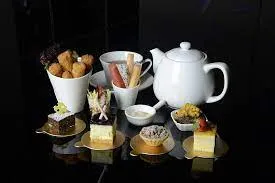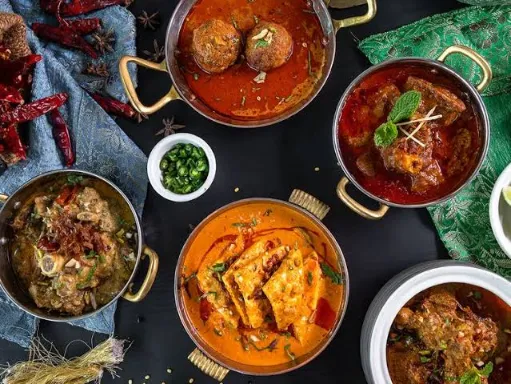No products in the cart.
English Afternoon Tea: The Traditional Delight
English Afternoon Tea is a British cultural tradition that has spread throughout the world. This lovely early-nineteenth-century ritual is more than just a meal; it’s a social gathering, a time of leisure, and a celebration of life’s finer pleasures.
With a variety of perfectly brewed teas, delicious sandwiches, freshly baked scones with clotted cream and jam, and a selection of pastries and cakes, the English Afternoon Tea is the right blend of elegance and comfort. The picturesque locations in which it is served, from fancy hotels and tiny tea houses to idyllic country gardens, frequently enhance the experience.
English Afternoon Tea has grown in popularity in recent years, with many individuals attempting to reproduce this traditional experience at home or exploring the finest venues to enjoy it. This book will take you on a tour through the world of English Afternoon Tea, whether you’re a tea aficionado, a foodie, or simply someone who loves the elegance of traditional rituals.

The Rich History of English Afternoon Tea
The origins of the English Afternoon Tea date back to the early 19th century. Anna, the Duchess of Bedford, is credited with introducing this delightful ritual. During the 1840s, she experienced a “sinking feeling” in the late afternoon due to the long gap between meals. To combat this, she began inviting friends over for tea and a selection of snacks in her boudoir.
This private affair soon became a fashionable social event, with ladies donning their best dresses to enjoy tea, sandwiches, and sweets. By the late 19th century, afternoon tea had become a cherished tradition, celebrated in households and tea rooms across Britain.
The Art of Preparing English Afternoon Tea
Preparing the perfect English Afternoon Tea is an art form. It begins with selecting the finest teas, often a blend of Assam, Ceylon, and Kenyan leaves. The water must be freshly boiled and poured over the tea leaves, allowing them to steep for the right amount of time.
Accompanying the tea is a selection of finger sandwiches, often filled with cucumber, smoked salmon, or egg and cress. Freshly baked scones are a must, served warm with clotted cream and strawberry jam. The experience is rounded off with a variety of pastries, cakes, and sometimes even chocolates.

Top 5 Best Places for English Afternoon Tea in London
London, the heart of Britain, boasts some of the most iconic venues for afternoon tea:
- The Ritz London: A timeless classic, The Ritz offers a luxurious tea experience with live piano music, silver teapots, and impeccable service.
- Claridge’s: Known for its art deco interiors and a menu that changes with the seasons, Claridge’s is a favorite among locals and tourists alike.
- The Savoy: Overlooking the River Thames, The Savoy offers a traditional tea experience with a modern twist.
- Fortnum & Mason: This historic venue has been serving tea since the 1700s and offers a wide selection of brews and treats.
- The Dorchester: With its opulent interiors and a vast tea selection, The Dorchester is a must-visit for tea enthusiasts.
The Quintessential English Afternoon Tea Experience in Cotswolds
The Cotswolds, with its rolling hills and historic villages, offers a serene backdrop for afternoon tea. Venues like The Old Bakery Tearoom and The Slaughters Manor House provide a cozy, countryside tea experience, complete with traditional treats and local brews.

The Difference Between Afternoon Tea and High Tea
While often used interchangeably, afternoon tea and high tea are distinct. Afternoon tea, as we’ve discussed, is a light meal served in the late afternoon, often in a formal setting. High tea, on the other hand, was a more substantial meal enjoyed by the working class after a long day’s work. It included heartier dishes like meat pies and was typically served at a high table, hence the name.
The Cultural Significance of English Afternoon Tea
English Afternoon Tea is not just a meal; it’s a cultural institution. Rooted in British history, it’s a testament to the country’s love for rituals and traditions. Over the years, it has become a symbol of sophistication, elegance, and the art of relaxation.
In an era dominated by fast food and hurried meals, the slow and deliberate pace of afternoon tea offers a refreshing change. It’s a time to pause, reflect, and engage in meaningful conversations. For many, it’s a cherished moment of tranquility in an otherwise hectic day.
Moreover, afternoon tea has played a pivotal role in British literature and cinema, from scenes in Jane Austen’s novels to the more recent “Downton Abbey” series. It’s a reflection of British society, its norms, and its evolution.

The Role of English Afternoon Tea in Modern British Society
While the tradition has its roots in the 19th century, it’s far from being a relic of the past. Today, afternoon tea has undergone a modern revival. Contemporary tea rooms and hotels offer a blend of traditional and innovative menus, catering to a new generation of tea enthusiasts.
Vegan and gluten-free options, themed teas, and exotic blends are now part of the afternoon tea lexicon. It’s a celebration of both heritage and innovation, proving that some traditions only get better with time.
The Global Influence of English Afternoon Tea
The sun never sets on the English Afternoon Tea empire. From Tokyo to New York, the tradition has found fans across the globe. International hotels and tea rooms have embraced this British custom, adding their unique twists and flavors. Whether it’s matcha scones in Japan or chai-infused pastries in India, the essence of afternoon tea remains unchanged – a moment of indulgence and relaxation.

The Future of English Afternoon Tea
As we look ahead, the future of English Afternoon Tea seems promising. With a renewed interest in mindfulness and slow living, more people are turning to traditions that offer a break from the digital world’s hustle and bustle. Tea rooms are becoming spaces of community and connection, where people can unplug and unwind.
Furthermore, with the rise of artisanal tea producers and gourmet patisseries, the quality and variety of offerings are better than ever. It’s a golden age for tea enthusiasts, with innovations and traditions going hand in hand.
Conclusion: The Enduring Charm of English Afternoon Tea
In conclusion, English Afternoon Tea is more than just a culinary delight; it’s a journey through time, a celebration of culture, and a moment of pure joy. Its enduring charm lies in its simplicity and the universal appeal of taking a moment for oneself. As we raise our teacups to this timeless tradition, we are reminded of the joys of savoring the present moment.

Read Further:
For those who wish to delve deeper into the world of English Afternoon Tea, the following resources provide a wealth of information:
- Vogue’s Guide to the Best Afternoon Tea in London
- Squaremeal’s Top Picks for Afternoon Tea in London
- Twinings on the History of Afternoon Tea
- About Britain’s Best Afternoon Tea Spots in the Cotswolds
- The Spruce Eats: Afternoon vs. High Tea – What’s the Difference?
Continue Reading: Tryngles Media
FAQs
What is the difference between afternoon tea and high tea?
As discussed, afternoon tea is a light meal with teas, scones, and sandwiches, while high tea is a heartier meal served in the early evening.
When is the best time for afternoon tea?
Traditionally, afternoon tea is served between 3:30 pm and 5 pm.
What should I wear to an afternoon tea session?
While casual attire is acceptable in many places, some upscale venues might require smart-casual or semi-formal attire.
How long does an afternoon tea session last?
Typically, it lasts for about 1.5 to 2 hours.
Can I host an afternoon tea at home?
Absolutely! With the right teas, treats, and company, you can recreate the afternoon tea experience at home.







